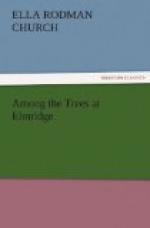“How funny that sounds!” exclaimed Malcolm. “Why, I couldn’t get along without my India-rubber when I make mistakes,”
“You might,” said his governess, “if you had some stale bread to rub with; for people have gotten along without a great many things which they now think necessary.”
“Miss Harson,” said Clara, “won’t you tell us, please, how they get the caoutch—whatever it is—and make it into India-rubber?”
“I will,” was the laughing reply, “when you can say the word properly. C-a-o-u-t-c-h-o-u-c—koochook.”
As Clara said, Miss Harson made things so easy to understand! and in a very short time the hard word was mastered.
“As I have never seen the sap gathered,” continued the young lady, “I shall have to read you an account of it, instead of telling you from my own experience; but the description is so plain that I think we shall all be able to understand it very well: ’At certain seasons of the year the natives visit some islands in the river Amazon that for many months are covered with water. As soon as the water subsides and a footing can be obtained the Indians arrive in parties, to seek for the trees. The Indian who comes every morning to collect the juice from the trunk has a number of trees allotted to him, and goes the round of the whole. The previous night he has made a long, deep cut in the bark of each and hung an earthen vessel beneath, to receive the thick, creamlike substance that trickles down. The vessel is filled by morning, and he pours the contents into one much larger and carries it to his hut. He is provided with a number of moulds of different shapes and sizes, and he dips them into the juice and puts them aside to dry. They are then dipped again, and the process is continued until the coat of India-rubber on the mould is of sufficient thickness. It is made black by passing it through the smoke of burning palm-nuts. The moulds are broken and taken out, leaving the India-rubber ready for sale, and pretty much as we used to see it in the shops before the people of this country had learned how to work it.’”
“That seems easy enough,” said Malcolm, “but how do they make it into gutta-percha?”
“Gutta-percha is not made,” replied his governess, “and it is taken from an entirely different tree, the Icosandra gutta, which grows in Southern Asia. The milky fluid is procured in the same way, but it is placed in vessels to evaporate, and the solid substance left at the bottom is the gutta-percha. It is not elastic, like India-rubber, and is called ‘vegetable leather’ because of its toughness and leathery appearance. It was discovered by an English traveler a long time before it was supposed to have any useful properties, but now it is considered a very valuable material. The wonderful submarine telegraph could not convey its messages between the Old World and the New were not its wires protected from injury by a coating of gutta-percha. Its unyielding nature and its not being elastic render it the very material needed. The long straps used in working machines are also made of gutta-percha, and this is another instance where its non-elasticity gives it the preference over India-rubber.”




